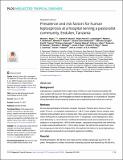Prevalence and risk factors for human leptospirosis at a hospital serving a pastoralist community, Endulen, Tanzania

View/
Date
2023-12-20Author
MazeI, Michael
Shirima, Gabriel
Lukambagire, Abdul-Hamid
Bodenham, Rebecca
Rubach, Matthew
Cash-Goldwasser, Shama
Carugati, Manuela
Thomas, Kate
Sakasaka, Philoteus
Mkenda, Nestory
Allan, Kathryn
Kazwala, Rudovick
Mmbaga, Blandina
Buza, Joram
Maro, Venance
Galloway, Renee
Haydon, Daniel
T., John
Halliday, Jo
Metadata
Show full item recordAbstract
Background
Leptospirosis is suspected to be a major cause of illness in rural Tanzania associated with close contact with livestock. We sought to determine leptospirosis prevalence, identify infecting Leptospira serogroups, and investigate risk factors for leptospirosis in a rural area of Tanzania where pastoralist animal husbandry practices and sustained livestock contact are common.
Methods
We enrolled participants at Endulen Hospital, Tanzania. Patients with a history of fever within 72 hours, or a tympanic temperature of ≥38.0°C were eligible. Serum samples were collected at presentation and 4–6 weeks later. Sera were tested using microscopic agglutination testing with 20 Leptospira serovars from 17 serogroups. Acute leptospirosis cases were defined by a ≥four-fold rise in antibody titre between acute and convalescent serum samples or a reciprocal titre ≥400 in either sample. Leptospira seropositivity was defined by a single reciprocal antibody titre ≥100 in either sample. We defined the predominant reactive serogroup as that with the highest titre. We explored risk factors for acute leptospirosis and Leptospira seropositivity using logistic regression modelling.
Results
Of 229 participants, 99 (43.2%) were male and the median (range) age was 27 (0, 78) years. Participation in at least one animal husbandry practice was reported by 160 (69.9%). We identified 18 (7.9%) cases of acute leptospirosis, with Djasiman 8 (44.4%) and Australis 7 (38.9%) the most common predominant reactive serogroups. Overall, 69 (30.1%) participants were Leptospira seropositive and the most common predominant reactive serogroups were Icterohaemorrhagiae (n = 20, 29.0%), Djasiman (n = 19, 27.5%), and Australis (n = 17, 24.6%). Milking cattle (OR 6.27, 95% CI 2.24–7.52) was a risk factor for acute leptospirosis, and milking goats (OR 2.35, 95% CI 1.07–5.16) was a risk factor for Leptospira seropositivity.
Conclusions
We identified leptospirosis in approximately one in twelve patients attending hospital with fever from this rural community. Interventions that reduce risks associated with milking livestock may reduce human infections.
URI
https://doi.org/10.1371/journal.pntd.0011855https://dspace.nm-aist.ac.tz/handle/20.500.12479/2458
